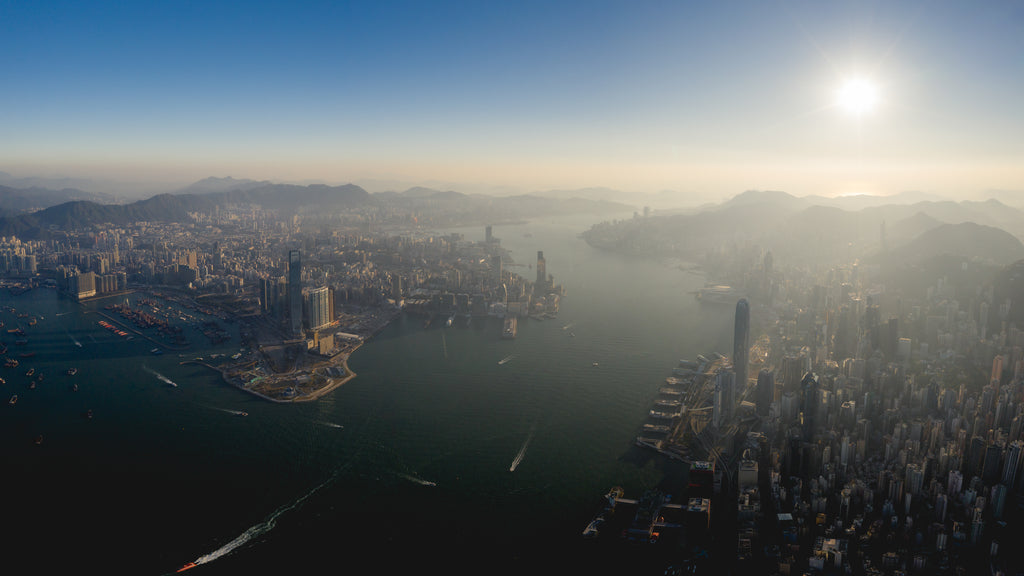Here at Beyond Visuals, we live for the giddy thrill of zipping around Hong Kong’s skyline. Being able to take in the details of our beautiful modern skyscrapers from dizzying altitudes, well, literally tops it off. Hong Kong’s spectacular setting - mountains, the harbour, and the dense forest of skyscrapers all in one frame - truly makes it an aerial photography paradise.

But how many of Hong Kong’s skyscrapers do you know? And how did we end up with the highest number of skyscrapers in the world? (Yes that’s right - Hong Kong has 355 skyscrapers, even more than Shenzhen, New York or Dubai.) Well, let us give you a quick fly through Hong Kong’s love affair with skyscrapers.
Hong Kong was described derisively as nothing more than a “barren rock” by Lord Palmerston in the 1840s, shortly after Hong Kong was ceded to the British. He meant this quite literally. Hong Kong lacked very little flat land, so space was always an issue. Even with extensive reclamation over the years, land was always in short supply. Hence, building upwards was always on the agenda, since spreading out was not.
This lack of space also explains why a lot of handsome Victorian and Edwardian style buildings that once lined the downtown waterfront were torn down, to be replaced by taller, modern skyscrapers. It is sad that there is not much left of our early architectural legacy, but in its place, we have lots of the tall buildings that we enjoy seeing!
The modern skyscraper boom began in earnest in the 1980s, when Hong Kong was transitioning from a manufacturing based economy to a financial services powerhouse. Offices were needed, and with land being scarce and valuable, the only way is up. Some of Hong Kong’s most memorable, but not no longer tallest, skyscrapers, were built in this period, including:
- the conical Hopewell Centre, often referred to affectionately as “The Big Cigar”;
- Jardine House, with its distinctive circular windows;
- Bank of China tower, with its striking triangulated facade resembling “The Vertical Knife”;
- the Lippo Towers, which are often referred to as the “Koala Buildings” thanks to its unusual design, which resembles koalas holding onto a tree trunk;
- the HSBC Headquarters Building, with its distinctive “Clothes Hanger” exposed structural frame.

Another skyscraper boom occurred shortly after Hong Kong’s transfer of sovereignty in 1997. It was in these years that our most iconic skyscrapers were completed. If you follow our accounts, none of these buildings would be new to you:
- The Center, with its distinctive octagonal design and its colourful evening light displays;
- Two IFC, a tower with a beautiful crown of lights and an emblem of Hong Kong’s skyline, despite being only the second tallest building in Hong Kong;
- Nina Tower, a landmark skyscraper in Tsuen Wan that was planned to be the tallest building when it was being designed in 1994, but which was taken down by to a still respectable height over concerns that it was on a busy flight path;
- One Island East, a landmark skyscraper in Eastern Hong Kong Island along with the neighbouring Taikoo Place cluster of office towers including One Taikoo Place;
- And of course, the ICC, the tallest of them all at a grand 484 metres, standing just across the water from Two IFC, like two modern lighthouses to beckon all into Hong Kong’s Victoria Harbour.

But hang on, you may be saying, surely that list is nowhere near 355 skyscrapers. And you’re right - Hong Kong has countless more. Since the 1990s, the majority of skyscrapers completed in Hong Kong are residential skyscrapers. These buildings aren’t always as distinctive and structurally imposing as commercial skyscrapers, but they’re very tall and worth keeping an eye out for. The skyline wouldn’t be the same without them!
Is Hong Kong still going through a skyscraper boom? Well, it seems that interest is waning. There are very few plots of land available to build truly large and tall commercial skyscrapers, and new urban planning and design requirements often cap building heights to ensure that new buildings do not materially affect the amenity of older parts of town nearby. New commercial buildings are, in fact, usually quite short. For example, those along the Kwun Tong Waterfront, where most of the new building designs are capped at around 20-30 storeys high (or 120m tall) barring a few exceptions. The few remaining new skyscrapers under construction are, interestingly, in places far away from downtown, where urban planning and design requirements are looser. LOHAS Park, a satellite suburb in Tseung Kwan O New Town on the very eastern end of the New Territories, is a cluster of some 38 skyscrapers - all between 55 to 60 storeys - and there will be quite a few more before the development is complete.
As we move into the 2020s, with building height limits in place, the era of supertall skyscrapers is giving way to landmark buildings that compensate their relatively short stature with striking designs. Freshly announced designs include:
- Zaha Hadid’s latest tower in Central, with an unusual puffy exterior;
- A landmark office tower in the new Kai Tak CBD by a Norwegian Architects - Snøhetta;
- the new Museum of Visual Culture (or otherwise known as M+) by Swiss Architects - Herzog & De Meuron
At Beyond Visuals, we’re definitely looking forward to the completion of these visionary projects.
Truly, Hong Kong is a city defined by its verticality, and the best way to take it all in is with a drone!
Thanks for reading and we'll see you next time.
The Beyond Visuals Team 
